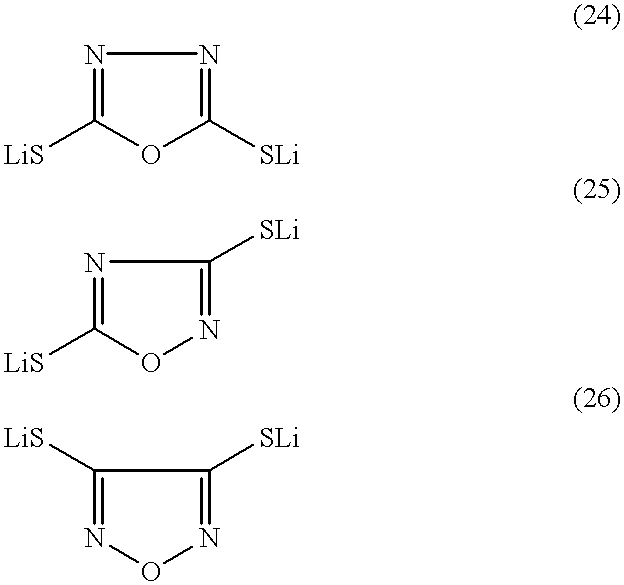Lithium secondary cell
a secondary cell and lithium technology, applied in the field of lithium secondary cells, can solve the problem of limiting the chargeable capacity of lithium ions initially in solid electroly
- Summary
- Abstract
- Description
- Claims
- Application Information
AI Technical Summary
Benefits of technology
Problems solved by technology
Method used
Image
Examples
Embodiment Construction
A lithium ion secondary cell having a positive electrode layer containing lithium TTCA, PAn, PPy and AB was evaluated for its discharge capacity.
In 16 g of NMP was dissolved 4.4 g of lithium TTCA powder, and the resulting solution was mixed with 16 g of a solution of PAn (12.5%) / NMP to prepare a lithium TTCA-PAn-NMP solution. This solution was applied on a 80 .mu.m-thick carbon film formed on a 30 .mu.m-thick titanium foil collector base material by means of glass bar coating (using a 150 .mu.m-thick spacer) and then baked at 80.degree. C. for 15 minutes under argon gas purging, followed by vacuum drying at 80.degree. C. for one hour to obtain a positive electrode layer film containing lithium TTCA and PAn at a weight ratio of lithium TTCA:PAn=2.2:1. A positive electrode having a diameter of 16 mm was punched out from this film.
Next, a 16 mm-diameter piece was punched out from a 0.2 mm-thick lithium foil and was laminated on a 30 .mu.m-thick titanium foil collector base material to ...
PUM
| Property | Measurement | Unit |
|---|---|---|
| charge capacity | aaaaa | aaaaa |
| thickness | aaaaa | aaaaa |
| diameter | aaaaa | aaaaa |
Abstract
Description
Claims
Application Information
 Login to View More
Login to View More - R&D
- Intellectual Property
- Life Sciences
- Materials
- Tech Scout
- Unparalleled Data Quality
- Higher Quality Content
- 60% Fewer Hallucinations
Browse by: Latest US Patents, China's latest patents, Technical Efficacy Thesaurus, Application Domain, Technology Topic, Popular Technical Reports.
© 2025 PatSnap. All rights reserved.Legal|Privacy policy|Modern Slavery Act Transparency Statement|Sitemap|About US| Contact US: help@patsnap.com



